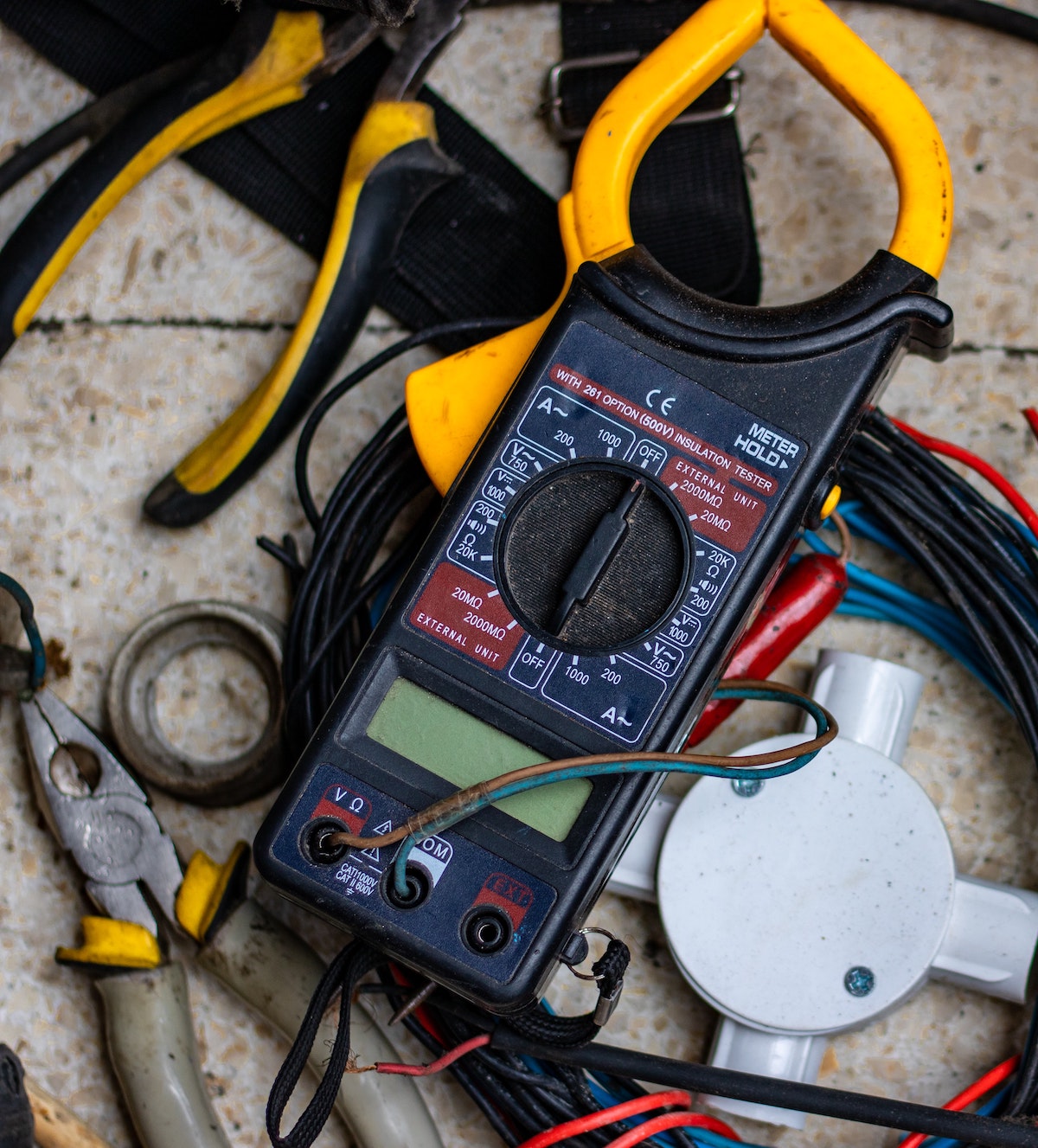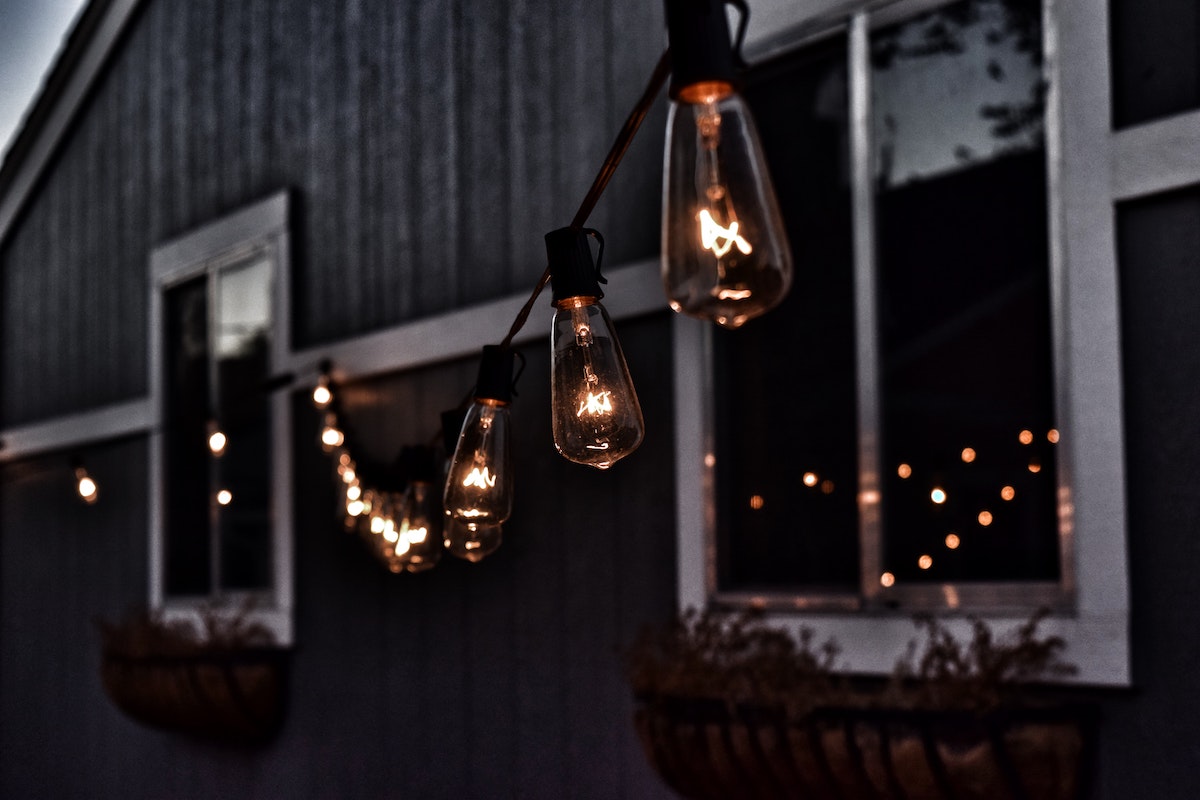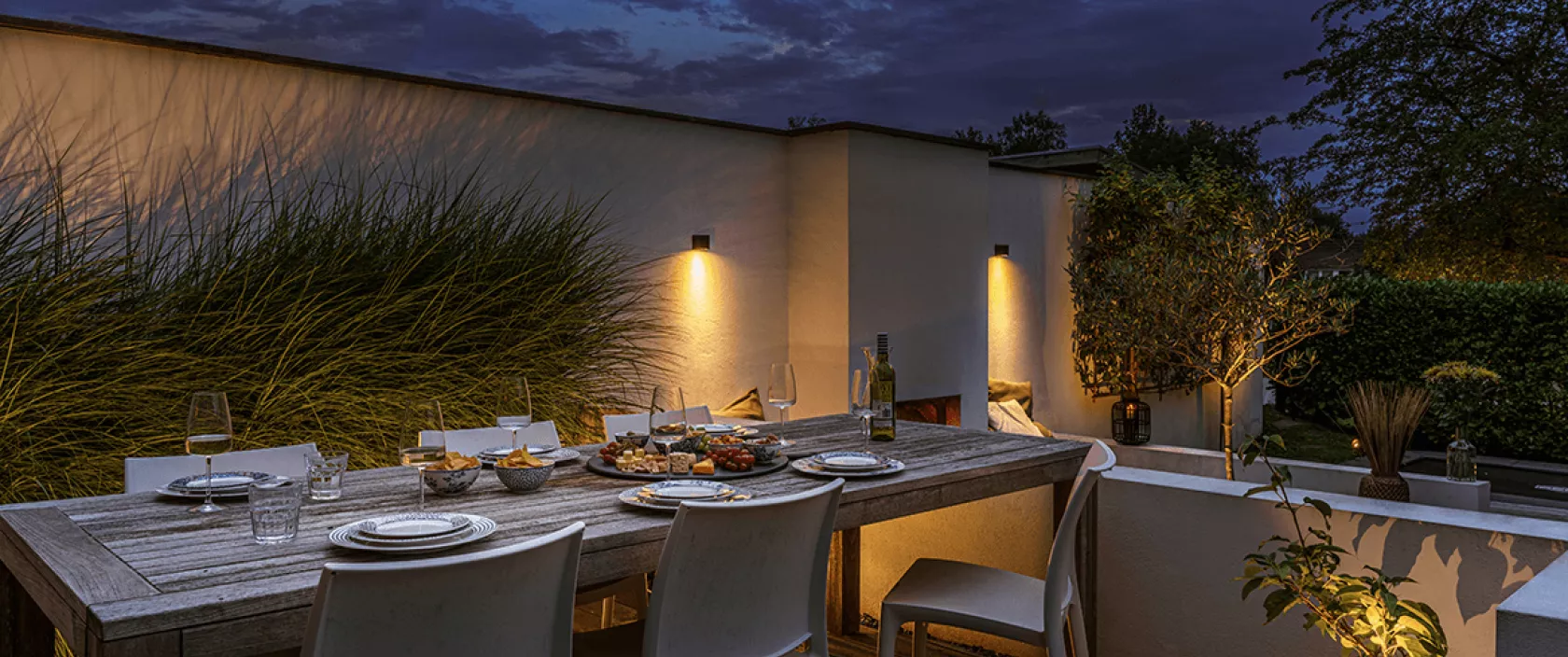Last month we published our guide to good outdoor lighting and that was more of a design primer focussing on the different types, effects, techniques and styles of outdoor lighting.
We did touch on safety but the Lazy Susan team were conscious that we wanted to take a more detailed look at how to safely install new garden lighting, share a few safety tips, and point you to a few helpful resources if you want to do it yourself.
First off, we must stress that if you’re wanting to wire garden lights into your mains power supply, and you don’t have the necessary experience, then it is a job best left to a professional qualified electrician.
Garden lights are generally low-voltage, but any time you’re working with a live electrical current, you need to know what you’re doing and, it goes without saying, safety is of paramount importance.
However, that said, because it is low voltage, garden lighting is relatively safe and easy for anyone with general electrical knowledge to self-install.
A low-voltage garden lighting system will generally comprise three components:
- Transformer
Plugs into an RCD or RCBO-protected outlet and reduces the 120-volt current to 12 volts. - Low-Voltage Outdoor Cables
Carries the current from the transformer to all your garden lights. - Garden Light Fittings
IP rated and connected to the transformer via the outdoor cable and wire connectors.
It sounds like a simple system when we break it down like this but that comes with a few words of caution...
Even with a low voltage electrical installation in your garden, it could still be notifiable under Part P of the Building Regulations in the UK.
If a new circuit has been run then it is classified as an addition and it will require an electrical installation certificate.
Garden lighting installations do not always need to be on their own circuit but it does ensure that the setup is flexible, can take the capacity of whatever lighting scheme you want to install, and is safe and compliant with the highest standards.
If you’re confident that you can install it correctly and that all safety measures are adhered to, then you can also install it without its own circuit.
This is classified as an alteration to an existing circuit and for that, under the latest revised regulations, it is no longer notifiable.
Any electrical work that's undertaken in your home such as adding a new switch/socket to power a new security light for example is only now notifiable if a new circuit is fitted.
You can find out more about the different types of electrical certifications on the NICEIC website and all new circuits added to your property must comply with the latest BS7671 IET Wiring Regulations.
If in any doubt, then our advice is to always use a qualified electrician who is registered with the self-certification scheme so that they can advise you, install it correctly/safely and provide the necessary certificate of approval if need be.
If you do carry out the work yourself and install a new circuit, then you must notify your Local Council’s Building Control Department to get any work you do inspected and tested.
Can you safely install your own garden lighting?
In our experience, the majority of garden lighting schemes are installed as an afterthought to the house being built. You're certainly more likely to find a solitary security light than any landscape/patio lighting if you purchase a new build.
If there is nothing installed then chances are you might want to think about a new alteration.

In this situation, the common route is for the power to be connected to an existing circuit (the aforementioned alteration) most often located at the rear of the property via a fused spur.
A fused spur is an alternative to a plug and socket that will allow you to run outdoor lighting from a single cable outside of the ring main. And, because they use a fuse, they will protect against electric shocks.
You can, for example, safely run garden lighting from an internal electrical source such as an existing light switch into a fused spur, and this would be classed as a minor alteration and is not notifiable as long as the connection to the garden lights is direct.
We would still recommend that the circuit is protected by an RCD (Residual Current Device) and that you check it can safely take the extra load/capacity you’re planning to put on that circuit before any work is done.
However, whilst garden lights don’t need to be on their own circuit, you do need to properly insulate the circuit you add them to in order to protect it from the elements. And that means using the correct cables, fixtures, fittings, etc too.
How to safely install your own garden lighting
Hiring a professional will ensure you get the best installation in terms of safety, functionality and flexibility, but that comes at a cost.
However, that cost is definitely worth paying if you want a full landscape lighting scheme that incorporates security, safety and accent lighting.
Of course, you don’t have to wire outdoor lighting into the mains at all, there are other 'safe' options such as solar-powered and plug-and-play systems that you can easily self-install. Of course, there are advantages and disadvantages with those types of fittings, in other words, potential compromise.
Lazy Susan’s advice, if you can’t afford to hire a professional and you don’t have the know-how to safely and correctly install, then definitely consider one of these options, but more of them a little further down.
If you are comfortable going down the DIY route, then before you start any electrical work, make sure you have the right tools for the job. This isn’t a job where corners can be cut and any old tools will do.
For example, a good non-contact voltage tester is essential so that you can test if your circuits are safe to work on and check they are receiving the correct/safe voltage when live.
If you’re in any doubt, or where you’re required by law, please always consult with a registered/qualified electrician.
Garden lighting installation safety advice

One thing that is super popular in our gardens at the moment is the hanging of festoon-style lighting (pictured above). They look fantastic draped from a pergola or between trees. But we’ve also heard a few self-install horror stories!
Homeowners assume they can just do a temporary install similar to Christmas outdoor lighting. And there’s often an assumption that this type of quick/simple plugin setup can be done without concern for safety or building regs.
However, the fact they’re not a permanent lighting installation, can in fact make them even more dangerous. For a starter, you should only ever install outdoor IP-Rated fixtures and fittings.
If you’re putting a light outside, then it has to be fit for purpose. Even if it’ll sit under a garden shelter or the eaves, if it is open to the elements, it must be designed to be weather-resistant.
We covered IP ratings in detail in our guide to garden lighting article, but we’ve summarised them again below. It is important if you’re buying new garden light fittings that you make sure you know what IP rating they have?
IP stands for ‘Ingress Protection’ and it is basically how much water and dirt can get into the unit, and therefore how “sealed” it is. At the highest rating, you would have submerged lighting for a swimming pool or pond, for example.
Always purchase the correct garden lights for the purpose you want them to perform, and below are the different common IP ratings/types sold in the UK:
- IP43
Sheltered outdoor areas such as a wall with overhanging roof or garden shed. - IP44
Exposed outdoor areas that are open to the elements such as a wall or pergola - IP65
Exposed outdoor areas that are open to heavy rain such as a path/deck. - IP67
Submerged in shallow water such as a garden pond or water feature. - IP68
Submerged in deep water deeper than 1 metre such as a swimming pool.
Get the correct outdoor bulbs
It isn’t just the garden light fitting itself too… They are rarely supplied with bulbs due to the different manufacturers, brands, etc.
The more reputable online retailers and garden lighting brands will recommend a suitable bulb so you can purchase together (often as a bundle deal with a handful of options in terms of light type, brightness, colour, etc).
If they don’t, then it is important that you only purchase the correct voltage of outdoor-rated bulbs.
The light unit itself will specify what watt bulb to use and it is important you follow the guidelines and don’t exceed the max volts. You can go lower but never higher!
For example, you could put a 30w bulb in a light that’s rated up to 60w but not 100w. It won't be as bright but it will prevent the light unit from overheating, which could seriously damage the whole fitting or worse.
The days of halogen bulbs are over too, LED is phasing them out, and that is 100% the way to go.
Get the correct outdoor cables
Just like bulbs, the correct wiring is also critical. Common gauges for garden lighting are 10 and 14-gauge wires. It is generally recommended to use 10-gauge if you have a larger garden to prevent voltage drop.
When it comes to running any cables in the ground, always install them after planting or away from any beds where the soil needs regular turning. This is to prevent accidental damage to the cable from any gardening tools.
If you do need to run cables through flower beds or under a lawn for example, then keep them close to the front edge, run them through an outdoor conduit for extra protection, and bury them to a depth of around 8 inches or so if possible.
Buy the right size and type of transformer
Purchasing the right size and type of transformer is also critical, as it is the transformer's job to convert the 120-volt current from inside your home into the safe low-voltage 12-volt current you need for garden lighting.
With the switchover from halogen to LED bulbs, we now only need a relatively small transformer to tackle the lighting scheme in an average-sized garden, with 60W and 150W being two of the more popular sizes sold in the UK.
However, the size is very much dependent on how many lights and the power they need... You need to add up the required wattage needed for each light fixture you plan to install and that number will tell you the size of transformer you need.
Our advice would be to always buy the next size up just in case you want to make any future changes to the scheme and add new units.
Whether it's required is open to debate but as previously stated, we would always install garden lighting on a circuit with RCD too.
Defined on Wikipedia as:
A residual-current device (RCD), residual-current circuit breaker (RCCB) or ground fault circuit interrupter (GFCI) is an electrical safety device that quickly breaks an electrical circuit with leakage current to the ground. It is to protect equipment and to reduce the risk of serious harm from an ongoing electric shock.
Whilst RCDs are not required for garden lighting as part of BS7671, our advice would be to install one if you’re looking at a full outdoor lighting scheme.
They are designed to protect against the risks of electrocution and fire caused by earth faults, which are rare, but at Lazy Susan we always prefer a belt and braces approach.
For example, if you accidentally cut through the outdoor cable, then it will prevent electrocution, so it makes for good safe practice in our opinion.
If all of the above is a little confusing, and trust me, we get confused writing it, then you have two options... Hire a professional or install one of the safe alternatives we mentioned earlier in this post.
Go solar-powered
Solar-powered garden lights get a bit of a bad rep but trust us they have improved dramatically. OK, they will never be as bright or flexible as wired (and they are dependent on the sun which is not something we see enough of) but there are some great modern fixtures that will deliver impact.
On the plus side, they’re an environmentally friendly solution that will eliminate the need for any wires and outdoor power. And they’ll save you money on your electricity bills, which let's face it, is something we all need to be exploring at this moment in time.
Install a plug-and-play garden lighting kit/system
If you want the ease of solar installation but the better lumens and reliability of wired lighting, then a plug-and-play kit is definitely the way to go in our opinion.
You can now purchase complete 12V plug-and-play low voltage landscape lighting kits online and from the big box home improvement stores. They will include everything you need; a plug-in transformer (power pack), light fixtures and cables.
No need to wire into the mains, simply plug into a socket, position the lights and connect the push-fit or screw-fit cables/connections. Easy and safe to install, and most importantly, no need for a professional spark.
If you go down this route then look for a reputable manufacturer that supplies a comprehensive range of kits, lighting solutions, parts, etc, if you need to purchase any additional lights, for example, it is easy to connect/compatible.

One such brand is the Garden Lights range from Techmar (pictured above), a complete 12-volt plug-and-play lighting system that’s easy to DIY install, easy to expand/add to and, as they put it:
Not only a breeze to install and easy to expand, but it is also safe for both humans and animals. Whether it's spring, summer, autumn or winter, with the 12-volt outdoor lighting from Garden Lights you can enjoy yourself until late in the evening.
Garden lighting installation videos
If you need any further advice or inspiration, then the following videos are a good place to start:
The Garden Light Shop has produced some great videos that look at the Techmar system such as the one above which shows you how easy it is to install the system with complete flexibility when using their Flex cables.
The DIY Guy has this great tutorial on installing outdoor lights and wiring up outdoor lighting (above). While the video below from Be Your Own Handyman @ Home shows you how to install a garden light fixture:
And I know we keep repeating ourselves but safety is critical, so if you do tackle your own electrical install, then please remember to:
- Switch off mains power
- Switch off the RCD
- Inform others of the work in progress and tape over the mains power switch to prevent it from accidentally being switched back on when you’re outside working.
- Test each circuit to ensure they are safe to work on
- Voltage test all finished work before you use it
- Install in accordance with your Local Building Regulations
- Install in compliance with the latest Wiring Regulations
If you have any tips on how to safely install new garden lighting that you’d like to share, please drop them in the comments below.



